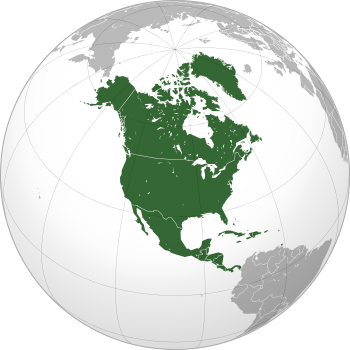List of supercontinents
This is a list of supercontinents. The list is written in reverse-chronological order (stratolithic order).
Present day
- Afro-Eurasia (~ 5 Ma — present day)
- Ocean-Eurasia (~ 5 Ma — present day)
- America (~ 15 Ma — present day)
- Eurasia (~ 60 Ma — present day or ~ 5 Ma (if considered a part of Afro-Eurasia))
Beringia–dependent
- Afro–Eurasia–America (aka Eurafroamerica, includes both North America and South America) (~ 5 Ma — end of Last Glacial Maximum) – fossil evidence indicates intermittent existence from ~ 55 Ma, now dependent on sea level
- Eurasia–America (aka Amasia) (~ 15 Ma — end of Last Glacial Maximum)
- Eurasia–North America (~ 55 Ma — end of Last Glacial Maximum)
Prehistoricals
- Gondwana (~510–~180 million years ago)
- Laurasia (~510–~200 million years ago)
- Pangaea (~300–~210 million years ago)
- Pannotia, also called Vendian (~600–~545 million years ago)
- Rodinia (~1.1 Ga–~750 million years ago)
- Columbia, also called Nuna (~1.8–1.5 Ga ago)
- Kenorland (~2.7 Ga ago). Neoarchean sanukitoid cratons and new continental crust formed Kenorland. Protracted tectonic magma plume rifting occurred 2.48 to 2.45 Ga and this contributed to the Paleoproterozoic glacial events in 2.45 to 2.22 Ga. Final breakup occurred ~2.1 Ga.
- Ur (~3 Ga ago). Classified as the earliest known landmass. Ur, however, was probably the largest, perhaps even the only continent three billion years ago. While probably not a supercontinent, one can argue that Ur was a supercontinent for its time, even if it was smaller than Australia is today. Still, an older rock formation now in Greenland dates back from Hadean times.
- Vaalbara (~3.6 Ga ago). Evidence is the Yilgarn Craton, Western Australia and the worldwide Archean greenstone belts that were subsequently spread out across Gondwana and Laurasia.
External links
This article is issued from Wikipedia - version of the 10/25/2016. The text is available under the Creative Commons Attribution/Share Alike but additional terms may apply for the media files.
.svg.png)
.svg.png)
.svg.png)
.svg.png)


.svg.png)
.svg.png)
.svg.png)
.svg.png)
.svg.png)